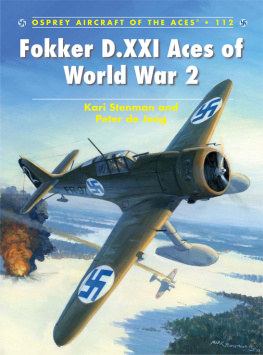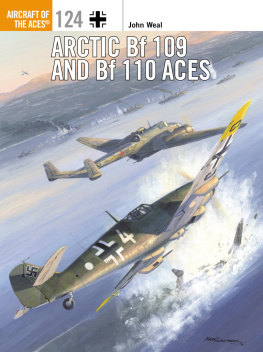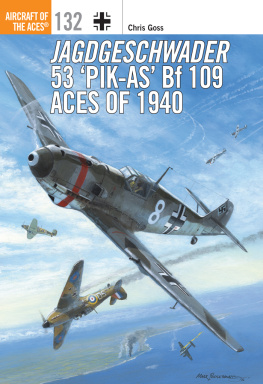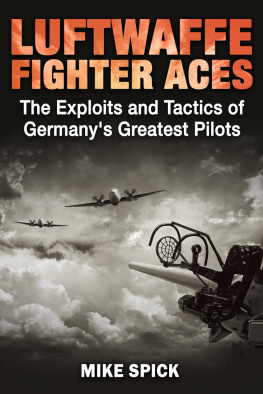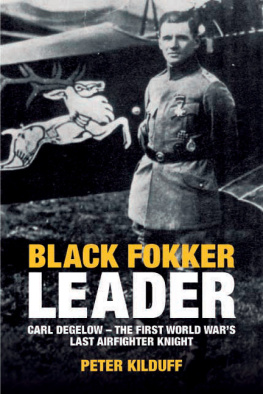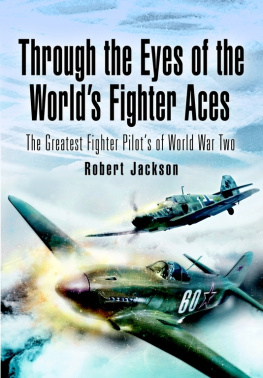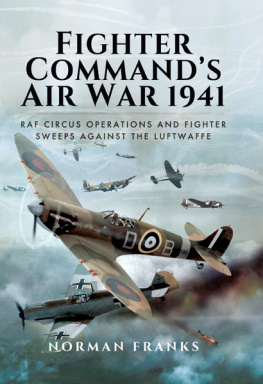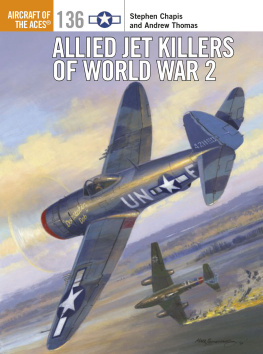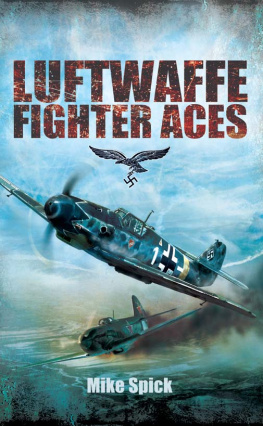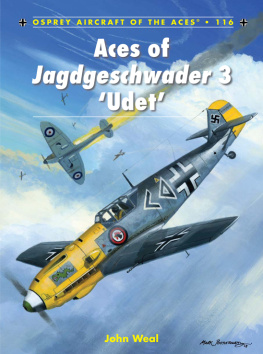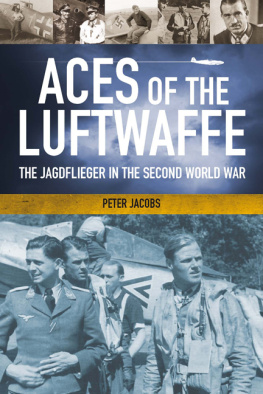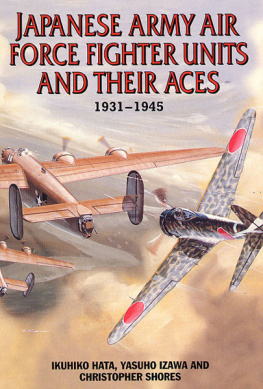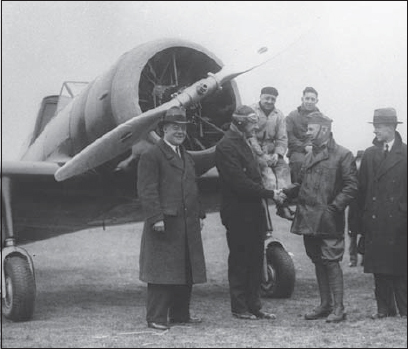SERIES EDITOR: TONY HOLMES
OSPREY AIRCRAFT OF THE ACES 1 12
Fokker D.XXI Aces of World War 2
Kari Stenman and Peter de Jong
D.XXIs FR-94, -95 and -86 of LeR 1 are seen here lined up for a parade held at Suur-Merijoki on 16 May 1939. Six months after this photograph was taken they were serving in the frontline with LLv 24. The men saluting are, from left to right, LLv 12 commander Maj A Nisonen, regiment commander Col Y Opas, LLv 14 commander Maj J Moilanen and LLv 10 commander Maj K Janarmo (Finnish Air Force)
CONTENTS
ORIGINS
T he Fokker D.XXI was obviously not one of the great fighters of World War 2, but for three minor neutral nations, Holland, Denmark and Finland, it was the nearest thing they had to the Supermarine Spitfire when they were invaded by the totalitarian juggernauts of Nazi Germany and Soviet Russia. Thanks largely to the Finnish pilots first-class training, the D.XXI, rather unexpectedly, shone like a polar star during the gruesome winter of war in 1939-40.
The fighter that had its finest hour in that vicious northern winter was originally intended for service in a very different environment, namely the tropical heat of the Netherlands East Indies (now Indonesia). Anthony Fokker, the companys founder, had been born in the colony in 1890, but grew up in Holland and built his first aeroplanes in Germany. The outbreak of World War 1 saw Fokker evolve into a major supplier of fighter aircraft to the Kaisers army, noteworthy designs being the Fokker Eindecker monoplanes, the Dr I triplane and the D VII biplane.
Subsequently based in Amsterdam and New York, Fokker enjoyed renewed success with both airliners and military aircraft during the 1920s. However, Anthony himself loathed scientific research and long-term investment. This meant that by 1934 his trademark mixed construction of fabric-covered steel-tube fuselages and wooden wings was obsolete, and his company was only a shadow of its former self, major export markets having dried up.
In May 1934 the Netherlands East Indies Army (NEIA) issued a requirement for a new fighter, demanding a 410 km/h (255 mph) top speed, with a fixed undercarriage and wood and metal construction for maintenance reasons. Armament was to comprise one fuselage-mounted heavy machine gun and two light machine guns in the wings that were to be adjustable through ten degrees upwards and sideways, although this latter requirement was eventually dropped.
The first three men to fly the D.XXI pose in front of the prototype after its maiden flight. NEIA Capt Van Lent shakes the hand of veteran factory pilot Emil Meinecke, while to the left of them is Fokkers chief constructor, Erich Schatzki, who had never designed or flown fighters before, but did fly his own brainchild. On the right is Fokker flight-test engineer Frans Stok. The wheel fairings and a cockpit canopy were not fitted for the first flight (T Postma)
A derivative of Fokkers elegant D.XVII biplane fighter, designated D.XIX, was dropped in favour of the low-wing Ontwerp (Design) 112. Development of the new monoplane was led by the companys new chief designer, Erich Schatzki, a former Junkers and Lufthansa engineer who was Jewish and had fled Hitlers Germany. Inline-engined sleek-fuselage variants were studied, Fokker showing considerable interest in the moteur-canon Hispano-Suiza 12Y engine, but the customer preferred an air-cooled radial. Stipulating the Bristol Mercury, the NEIA cabled its approval of type D two one, as the new fighter had, meanwhile, been designated, on 1 April 1935. Fokker was inconsistent in its 1935 abandonment of Roman numerals in its designations, and the D.21 is better known internationally as the D.XXI.
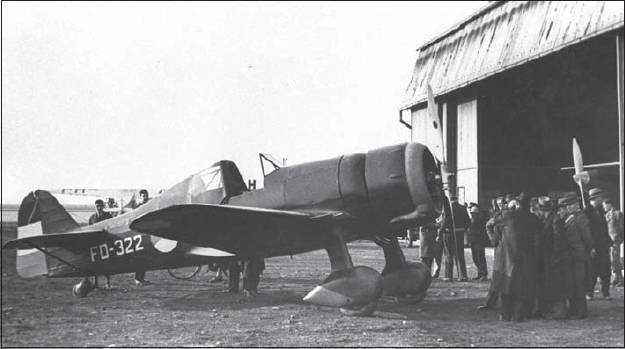
The prototype arrives at the Fokker flight-test department at Schiphol Airport on 16 March 1936, initial testing having taken place at Eindhoven. The scene must have been similar on 1 May, when a new pilot barely managed to land the aircraft after making a mess of a spin test the rudder was soon enlarged to improve spin recovery. The prototype wore full NEIA markings and the serial FD-322 (T Postma)
Owing to soggy conditions at Amsterdams Schiphol Airport, the prototype, powered by a 645 hp Mercury VI, first took to the air from Eindhovens Welschap airfield on 27 February 1936, flown by 43-year-old factory pilot Emil Meinecke. Bertus Somer, a young flying instructor and former fighter pilot, was subsequently engaged for spinning trials, but he panicked during an early test flight and nearly crashed the aircraft on 1 May, spreading word that the D.XXI was dangerous. To make matters worse, the NEIA had meanwhile decided to buy bombers rather than any fighters, and the metropolitan Dutch Army deemed the D.XXI too slow.
Former Messerschmitt test pilot Bubi Knoetzsch had to be flown in to establish that spin recovery in the D.XXI was, in fact, normal, although the type was prone to stalling into a spin owing to its flat wing, which had little dihedral and no washout. Famous French aerobatic pilot Michel Dtroyat also went to Amsterdam to fly the D.XXI, and insisted that lateral stability should be increased.
Ilmavoimat (Finnish Air Force) Capt Gustaf Eka Magnusson, who flew the prototype on 8 July 1936, did not share Dtroyats dim view, however, finding it a sharp, responsive fighter. The D.XXIs time-honoured mixed construction was also light yet strong, giving the aircraft good climbing and diving characteristics. As a result of Magnussons recommendations, Fokkers seemingly ill-fated fighter emerged as the leading contender in Finlands 1936 fighter contest.
The Finns were already involved with Fokker designs, as in the spring of 1936 the companys C.X had been chosen to replace the earlier Fokker C.V army co-operation aircraft in Ilmavoimat service. This purchase was part of a new five-year plan, which also included a sufficient number of fighters to equip three squadrons with 27 aircraft each. The air force was standardising on the Mercury engine, and like the powerplant, the selected aircraft type was to be manufactured locally. This meant victory for the D.XXI over the competing PZL P.24, since Valtion Lentokonetehdas (VL), the Finnish State Aircraft Factory, could not cope with the Polish aeroplanes metal construction. Finland thus became the first customer for Fokkers new low-wing monoplane fighter, placing an order for seven aircraft on 18 November 1936, and also acquiring a licence to produce twice as many at the VL factory.
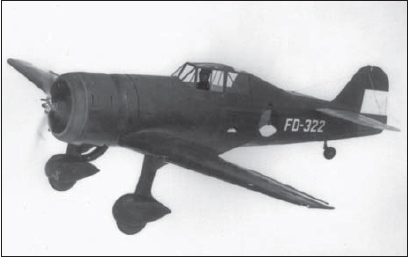
The prototype in its definitive form, with an enlarged rudder, a three-bladed propeller and the tailwheel fairing removed. Capt Van Lent took the aircraft aloft on its 151st flight (a dedicated aerial photography flight) on 18 June 1936. His Finnish colleague Eka Magnusson had flown it for the first time ten days earlier (T Postma)
During the first half of 1937 the government of Spain, where civil war had broken out the previous summer, secretly ordered 50 D.XXIs for local production, as well as G.I and C.X aircraft, and in July the Danish Army contracted for two D.XXIs, plus the rights to build ten more in its own workshops. Paradoxically, the types conventional construction had made it a success. Finally, the Dutch government placed an order after all, signing a contract for 36 D.XXIs, as well as 36 twin-engined G.Is, in late 1937. The Dutch Armys change of mind came about because the D.XXI was considered suitable to fulfil a new frontal fighter requirement. Production D.XXIs were to have 830 hp Mercury VII or VIII engines, although the Spaniards opted for the American Wright R-1820 Cyclone radial.
Next page
